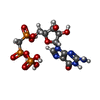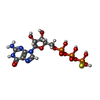+Search query
-Structure paper
| Title | Separating the effects of nucleotide and EB binding on microtubule structure. |
|---|---|
| Journal, issue, pages | Proc Natl Acad Sci U S A, Vol. 115, Issue 27, Page E6191-E6200, Year 2018 |
| Publish date | Jul 3, 2018 |
 Authors Authors | Rui Zhang / Benjamin LaFrance / Eva Nogales /  |
| PubMed Abstract | Microtubules (MTs) are polymers assembled from αβ-tubulin heterodimers that display the hallmark behavior of dynamic instability. MT dynamics are driven by GTP hydrolysis within the MT lattice, and ...Microtubules (MTs) are polymers assembled from αβ-tubulin heterodimers that display the hallmark behavior of dynamic instability. MT dynamics are driven by GTP hydrolysis within the MT lattice, and are highly regulated by a number of MT-associated proteins (MAPs). How MAPs affect MTs is still not fully understood, partly due to a lack of high-resolution structural data on undecorated MTs, which need to serve as a baseline for further comparisons. Here we report three structures of MTs in different nucleotide states (GMPCPP, GDP, and GTPγS) at near-atomic resolution and in the absence of any binding proteins. These structures allowed us to differentiate the effects of nucleotide state versus MAP binding on MT structure. Kinesin binding has a small effect on the extended, GMPCPP-bound lattice, but hardly affects the compacted GDP-MT lattice, while binding of end-binding (EB) proteins can induce lattice compaction (together with lattice twist) in MTs that were initially in an extended and more stable state. We propose a MT lattice-centric model in which the MT lattice serves as a platform that integrates internal tubulin signals, such as nucleotide state, with outside signals, such as binding of MAPs or mechanical forces, resulting in global lattice rearrangements that in turn affect the affinity of other MT partners and result in the exquisite regulation of MT dynamics. |
 External links External links |  Proc Natl Acad Sci U S A / Proc Natl Acad Sci U S A /  PubMed:29915050 / PubMed:29915050 /  PubMed Central PubMed Central |
| Methods | EM (helical sym.) |
| Resolution | 3.1 - 4.3 Å |
| Structure data |  EMDB-7976:  EMDB-7977: |
| Chemicals |  ChemComp-GTP:  ChemComp-MG:  ChemComp-G2P:  ChemComp-GDP:  ChemComp-GSP: |
| Source |
|
 Keywords Keywords | CELL CYCLE / microtubule / cytoskeleton / GMPCPP / seam / dynamic / GTPgammaS |
 Movie
Movie Controller
Controller Structure viewers
Structure viewers About Yorodumi Papers
About Yorodumi Papers










 Homo sapiens (human)
Homo sapiens (human)